Double-check the name – it’s not the white tree frog, it’s white’s. In fact, there is nothing white about this tiny cutesy pet. Its unique way of croaking will surely pull your heartstrings.
Although a lot of people say, a white’s tree frog’s croaking sounds like a dog’s barking, I found the noises to be similar to a duck’s. Even though its shape is adorable, its small round body makes it look adorable.
Am I making you curious about it? How about going downward and reading up a bit more…
![White’s Tree Frog: [Behavior, Habitat, Diet, Health]](https://spectrapets.com/wp-content/uploads/2023/02/Whites-Tree-Frog-Behavior-Habitat-Diet-Health.jpg)
What is a White’s Tree Frog?
The White’s tree frog, which is also well-known as the Australian green tree frog. This tree frog belongs to the family Hylidae. It has about 100 different species from the Ranoidea and Nyctimystes genera.
White’s Tree Frog is named after its discoverer, John White. He described it for the first time in 1790. It is endemic to Australia, Indonesia, and New Guinea.
The White’s tree frog is well-known for its small size, drowsy eyes, and smiling lips, some people even call it the smiley frog. Its waxy skin helps it to endure more arid circumstances than other tree frogs. This makes it a good pet for homes. A White’s tree frog is a fantastic option for a beginner frog keeper.
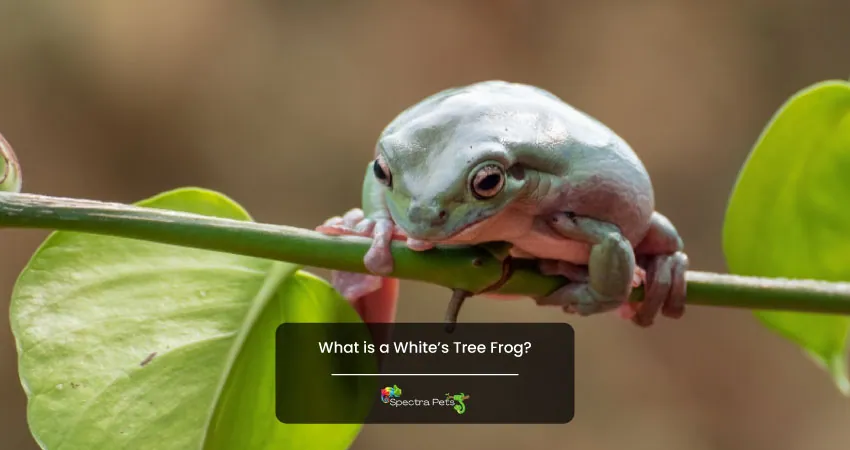
Behaviors: Croaking, Grunting, and Screaming
White’s tree frogs are typically submissive and peaceful. They can easily tolerate mild handling. Because of this, they are simple to manipulate even for novices.
These frogs are nocturnal, which means that they are active throughout the night, and they sleep during the day unless they are disturbed.
In order to attract potential mates, the males typically gather in groups close to water sources and make a croaking sound repeatedly. Keepers often describe this as sounding as groaning or yelling. When they sense danger, they let out a loud, high-pitched alarm cry.
Appearance
White’s tree frogs have green, blue-green, or gray backs and bellies. Some might have white or yellow marks on their backs and flanks. They have the ability to change their colors depending on the weather.
Female White’s tree frogs have smooth white throats. Unlike females, males have a gray, wrinkled vocal sac on the base of their necks. They also have black nuptial pads on the underside of their thumbs.
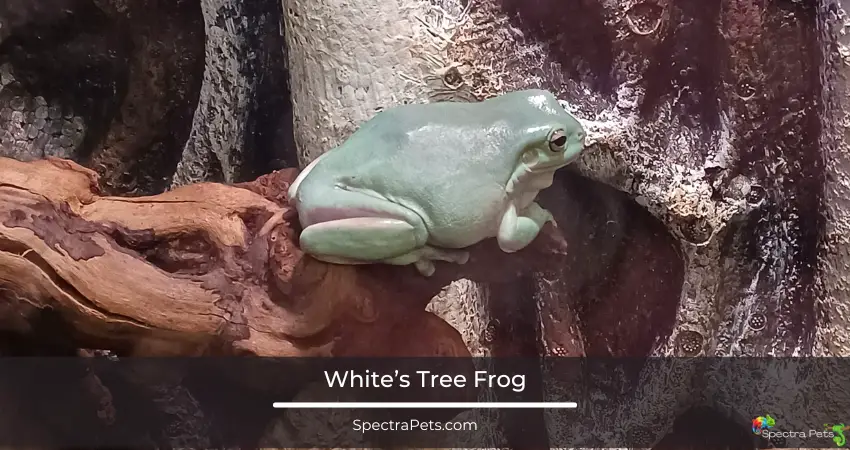
Females can grow up to 4.5 inches whereas males can grow only up to 3.5. There are some similarities between male and females. Both of their bodies are spherical and have webbing between their toes.
There is a fatty ridge of tissue on top of these tree frogs’ skulls, and there is a little fold of fat under each eye, giving them a worn appearance. Because of their plump appearance and the fat folds on their bodies, people refer to them as ‘dumpy tree frogs’.
These tree frogs have large toe pads, and the webbing between their fingers is only partially developed whereas the webbing between their toes is almost complete. They have horizontal pupils.
It is interesting to note that their skin has strong antibacterial and antifungal properties. This makes them more resistant to fungal infections, which are the leading cause of death for amphibians.
Read More: Do Tree Frogs Change Colors?
Habitat
White’s Tree Frogs are found only in Indonesia, Papua New Guinea, Australia, and New Zealand. Their natural habitat is the treetops of tropical rainforests.
The habitat of White’s tree frogs extends beyond the traditional tropical rain forests. During the dry season, White’s tree frog spent most of their time around the trees. They hide in the tree hollows or secrete a milky liquid called “caerviein”. This helps them to hydrate.
They also form cocoons around their bodies to keep in as much moisture as possible. To minimize the amount of water loss, they hunt for insects and nests in cracks and crevices.
The White’s tree frogs are usually a solitary creature that only congregates with other individuals during the mating season. You can keep them together if they are about the same size and age. This is to prevent one of them from eating the other.
If you want to breed frogs, purchase more than one to increase your chances of finding a partner. Make sure that all the frogs have enough food, since froglets will sometimes eat each other if they are hungry enough.
These tree frogs do not behave hostilely against one another in any way. Furthermore, there is not much evidence of dominance hierarchies among them. You can keep both males and females in the same location so long as there is not too much competition for space.
They spend the most of their time in captivity perched on the highest points of the cage. They will only come to the ground level to drink from the bowl of water or hunt their prey. Compared to adults, young ones are typically more active. The evening brings forth more activity from White’s tree frogs of all ages.
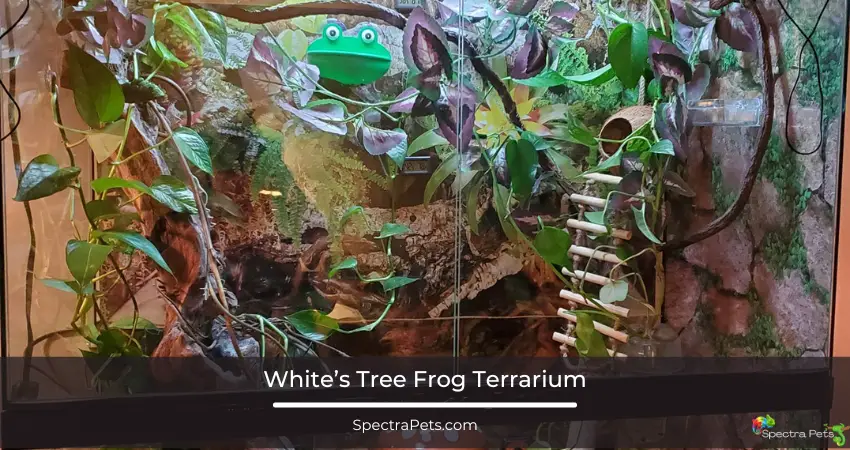
White’s Tree Frog can survive both in dry and wet environments. Their skin can adapt to dry environments but has a preference for damp, wooded habitats to live in. They are most common in the treetops that are located in proximity to bodies of water, but they have been seen in terrestrial settings as well.
They like ancient eucalyptus trees that have hollows filled with water where they may hide themselves. Frogs are able to get access to water because rainwater pools in cracks and fissures in tree trunks, as well as on cup-shaped leaves and plants. Since it often rains there, the frogs can relax knowing that there will always be a fresh source of water.
They’re found across 1,574,000 square miles. They depend on camouflage to hide themselves, which serves them well throughout the day when they are not actively hunting.
White’s tree frogs can cohabit with humans in countryside and agricultural areas due to their versatility. You can also find them in places such as water tanks, civic reservoirs, and public restrooms. In the sweltering months of summer, they could show up on the terraces of houses or even go so far as to enter them in search of a source of moisture.
The typical lifespan of white’s tree frogs is around 16 years. However, there is a record of surviving for 21 years under human care.
How Much Do White’s Tree Frogs Cost And Where To Buy?
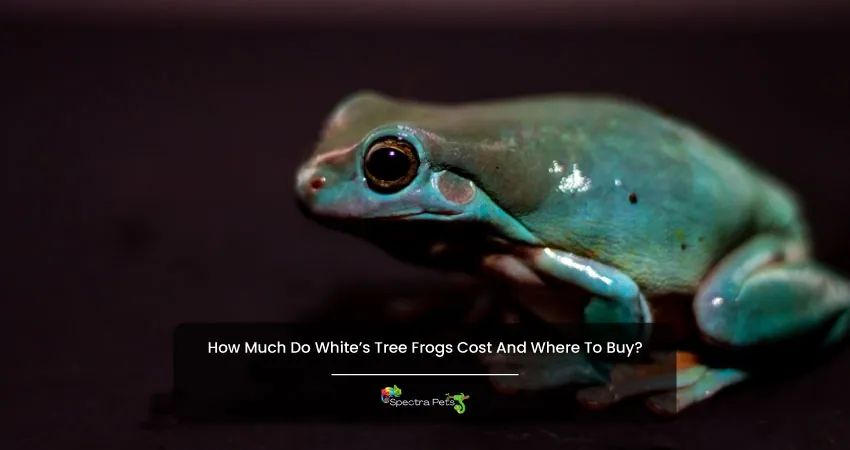
Generally, white’s tree frogs are somewhat cheap compared to other tree frogs. They cost around $30 each. Wild-caught white’s tree frogs may bear deadly fungal diseases harmful to people. So it will be better for you to collect your wannabe friends from reputable captive breeders. Usually, captive bred frogs get stronger and healthier than wild ones. Because they are already adaptable to the captive condition.
White’s Tree Frog Diet
The primary source of diet for the white’s tree frogs are insects. Sometimes adults may feed on pink mice. They also feed on –
- Live crickets
- Earthworms
- Waxworms
- Hornworms
- Mealworms
- Phoenix worms
- Dubia roaches

Common Health Issue
Chytridiomycosis, an infection produced by the chytrid fungus, is the greatest danger to the White’s tree frog’s health. They experience fatigue and a loss of body weight.
This infection spreads rapidly in the wild and has led to a significant drop in the populations of most tree frogs across the globe. There are a very few medications available for it.
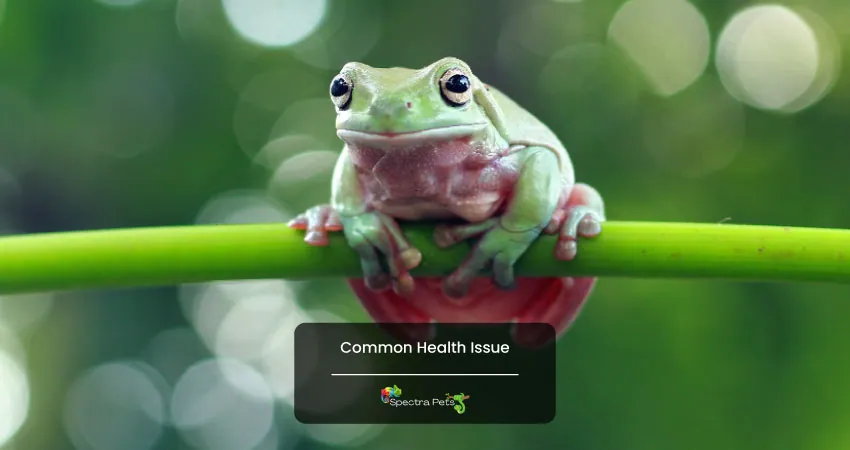
Handling
In contrast to many other species of frogs, White’s Tree Frogs are tolerant of some amount of handling. But you should do it deliberately and with care, and they often become accustomed to it. It is best to avoid handling frogs unless it is absolutely essential. Frogs can easily absorb bacteria and oils from human skin due to their extremely porous and fragile skin. When handling your frog, you should always use gloves that are wet but not powdered.
To protect themselves from potential threats, White’s tree frogs secrete poison from their skin. It is important to keep the frog’s secretions away from your eyes, mouth, and any open wounds you may have. This is because the secretion may be irritating to people.
Reproduction and development
The sexually mature age of White’s tree frogs is two years. After getting one-year-old, they acquire the sexual maturity level necessary to reproduce. They feed themselves for a couple of days during the wet season of summer, and then they begin to reproduce. Adult White’s Tree Frogs aren’t too difficult to determine the gender of. Females are much bigger than males, having heads that are both broader and more robust. Females are typically about an inch longer and 25% heavier than males.
During mating season, the males develop a black thumb pad. It helps them to hold the females while they mate. This may continue for some days until the female deposits her eggs. Males typically have a stretched-out throat, perhaps as a consequence of all those nighttime cries.
The female releases eggs with immense power that they pass through the cloud of deposited sperm and land up to 0.5 meters away. Usually, a clutch may include around 150–300 eggs. The eggs drop to the bottom once they fertilize. The hatching process starts 28–36 hours later. In favorable conditions, metamorphosis can continue up to 2–3 weeks.
Fun Facts
- In the medical industry they have a great value for their extracts from their skin. They use these extracts to fight bacteria like staphylococcus. These bacteria can lower your blood pressure, causing abscesses. Herpes simplex virus (HSV) cold sores are also curable with this extract.
- Their scientific name is Ranoidea caerulea. The Latin word for “blue” is “caerulea”. But usually, they can’t be seen as blue, rather they are bright green.
White’s Tree Frog: Frequently Asked Question
Is white’s tree frog a toxic species?
Are white’s tree frogs suitable as pets?
Can we put other tree frogs with white’s tree frogs?
Are White’s tree frogs popular?
Are the white’s tree frogs nocturnal?
Do white’s tree frogs carry diseases?
In Conclusion
By now, I’m sure you’ve had an amazing experience following the life of a White’s tree frog. The goal was to gain a better understanding of what a White’s tree frog is. If reading this blog will help you pick up the right pet for you as a source of joy and companionship, I’d be more than happy.
